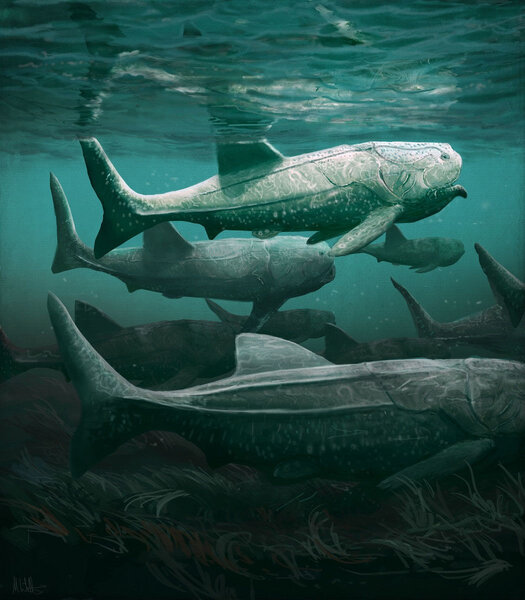Create a free profile to get unlimited access to exclusive videos, sweepstakes, and more!
With its own built-in armor, this prehistoric monster fish had no fear when it came to head-butting its dinner

Before there were ever the thunderous footsteps of a brontosaurs or the terrifying teeth of a T. Rex, a monster armored fish existed—and its armor isn’t even the weirdest thing about it.
Titanichthys was a behemoth by Devonian standards. 380 million years ago, the 16-foot fish ruled prehistoric waters long before anything on land got huge. There’s just one thing. You would probably expect this creature to have teeth as imposing as its size, but unlike some of its fanged and fearsome relatives, it didn’t. So how did it manage to feed? No fossils revealing that have emerged until now. Sam Coatham of the Univeristy of Bristol, a postgrad studying paleobiology, decided to instead use an existing Titanichthys jaw fossil to find out. Seems this fish was fierce in its own way. It slammed headfirst into massive amounts of zooplankton to force them into its gaping maw.
Maybe you wouldn’t expect an apex predator to evolve into a megaplanktivore (a deceptively large creature which preferred plankton over larger prey), but it definitely happened.
“There is little direct proof … However, we can infer from the rise in diversity of predators with high energetic demands that there was probably sufficient productivity to support relatively complex ecosystems,” Coatham said in a study recently published in Royal Society Open Science. “Consequently, it seems probable that productivity did increase, potentially facilitating the evolution of a giant suspension feeder in the Devonian.”
Suspension feeders lurk underwater, catching floating food such as plankton in their mouths. The way Titanichthys is thought to have devoured its dinner is a type of suspension feeding called continuous ram feeding. This involves the predator shoving its open mouth into a mass of prey and catching as much as it possibly can before that prey gets on the move again.
Both prey and surrounding water are swallowed into the cavernous abyss beyond its jaws, but was probably a living horror movie for plankton and other micro-creatures that got engulfed. Coatham and his team studied the lower jawbone of Titanichthys and compared it to other extinct and extant species of fish. Next to the bones of fish that went for larger prey, its jaw was determined not to have been strong enough for that.
Extant fish closest to Titanichthys include the basking shark and the whale shark, both giant filter feeders that only look as if they would be dangerous to humans. Because Titanichthys is believed to have evolved from earlier durophagous fish, which were able to bite down on prey with hard shells, it is thought to be even closer to the whale shark, which is also believed to have had durophagous predecessors but evolved into a suspension feeder.
This evolution possibly happened after the first trees appeared on land during the Devonian period. Their roots reached deep, affecting the breakdown of rocks with a high silicone content, and the nutrients from soil and rocks would end up being carried into the oceans. This brought on a mass extinction event triggered by the lack of oxygen in the darkest depths, but more nutrients may have been the reason that fish and other creatures that previously fed on prey with shells slowly turned into megaplanktivores.
“There are almost certainly other planktivorous species in the fossil record yet to be identified,” Coatham said, adding that “The common reduction in stress [and] strain resistance observed here could be used as an indicator of planktivory in such cases where it seems plausible but cannot be identified definitively, due to the absence of fossilized suspension-feeding structures.”
So maybe Titanichthys was no Jaws, even though it must have looked like nightmare fuel, but that is still some sick armor.



























